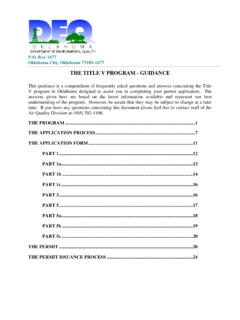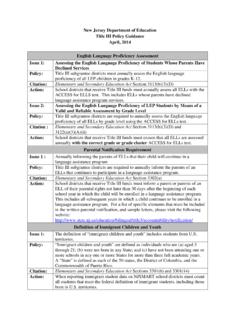Transcription of OSSE FEDERAL GRANT TOOLKIT Consolidated Federal …
1 OSSE FEDERAL GRANT TOOLKIT Consolidated FEDERAL Program Guidance2014-2015 Office of the State Superintendent of Education (OSSE), Washington, DCOSSE FEDERAL GRANT TOOLKIT : Consolidated FEDERAL Program GuidanceCopyright 2014 Office of the State Superintendent of Educaiton (OSSE)Washington, District of ColumbiaThis material, and all examples are provided only to illustrate how ED funds can be coordinated and should not be used in lieu of FEDERAL law. OSSE is not mandating any particular strategy, or endorsing one strategy over of Contents1 Introduction to Consolidated FEDERAL Program Guidance2 Frequently Asked Questions (FAQs)11 Part I: Consolidated Application guidance : title I, title II, title III12 title I16 title II17 title III21 Part II: IDEA Part B Fiscal Guidance22 Section I: Funding Overview22 Section II: Funding Requirements 23 Section III: Monitoring & Compliance 24 Section IV: Allowable Cost Chart29 Part III: Carl D.
2 Perkins Guidance30 Funding Allocation (Perkins Sections 131 & 132) 32 CTE Application Plans34 CTE Programs/Programs of Study38 Allowable Use of Funds (Perkins Section 135) 44 Supplement Not Supplant (Perkins Section 311) 44 Accountability 47 Time Distribution47 Inventory/Equipment50 Equitable Access & Participation guidance (Perkins Section 122; GEPS Section 427)55 Part IV: Appendix: Examples of Coordinated Use of FEDERAL Funds 57 Effective Staffing Practices and Professional Development Examples58 Effective Use of Data Examples59 Rigorous Curriculum and Instruction Examples60 School Climate and Culture Examples61 Effective Family and Community Engagement Examples62 Detailed ExamplesOSSE FEDERAL GRANT ToolkitCONTACT INFORMATIONFor questions about the Enterprise grants Management System (EGMS), please visit: or contact the OSSE Help Desk at: or (202) general information, contact the Office of grants Management and Compliance at: speicific information on program guidance , please contact: Consolidated Application: or Carl D.
3 Perkins: or visit: FEDERAL GRANT ToolkitConsolidated FEDERAL Program guidance 1 INTRODUCTION TO PROGRAM GUIDANCEAs the District of Columbia s state educational agency, FEDERAL law requires the Office of the State Superintendent of Education (OSSE) to ensure FEDERAL money is spent responsibly and effectively. Therefore, OSSE developed this guidance to help DC s local education agencies (LEAs), schools, and other recipients of FEDERAL GRANT funds understand how they may spend the money they receive and the systems they must have in place to manage their programs is important because FEDERAL law presents LEAs and schools with many options for spending program funds to improve student achievement.
4 Often, program funds can be used in ways LEAs and schools may not be aware of, but maximizing these spending options requires: XA robust understanding of FEDERAL spending rules, and XStrong management systems. To that end, this guidance includes questions and answers on the: XCoordination of spending FEDERAL education program funds; XImportant spending rules that apply to FEDERAL education grants ; XThe documentation required to support salaries paid for with FEDERAL grants ; and XThe systems, financial management, inventory, etc., and related documentation required to appropriately track and spend FEDERAL education I of this guidance provides information specific to DC s programs, specifically title I, Part A, title II, Part A, title III, Part A of the Elementary and Secondary Education Act (ESEA).
5 Part II provides information specific to IDEA Part B, and Part III provides informtaion specific to programs under Carl D. Perkins grants . The Appendix of this document provides some examples of how LEAs can coordinate spending of FEDERAL education funds to support comprehensive initiatives. Questions about this guidance should be directed to Office of grants Management and FEDERAL GRANT TOOLKIT 2 FREQUENTLY ASKED QUESTIONSW hile each Department of Education (ED) GRANT has its own purpose and rules, OSSE encourages recipients to think about ways to coordinate grants to support comprehensive activities to maximize the impact of FEDERAL funds. For example, a local education agencies (LEAs) might use a combination of title I, title II, title III, and IDEA, Part B funds to provide professional development for teachers on effective interventions for struggling type of coordinated approach requires recipients to plan for activities across FEDERAL funding streams, which can be challenging, but is encouraged by OSSE and permitted by Is coordinated GRANT spending permitted by FEDERAL law?
6 Yes, FEDERAL law authorizes recipients to coordinate spending from different grants as long as the recipient: XFollows the FEDERAL spending rules discussed throughout Consolidated FEDERAL Prgoram guidance ; and XTracks how FEDERAL funds are spent. Using multiple funding sources to support a project does not mean the funds must be combined together or Consolidated from an accounting perspective. Instead, coordinated spending can be thought of as a different way to approach FEDERAL funds and begins with robust planning. A2. How can an LEA approach the coordinated spending of FEDERAL education GRANT dollars?Rather than programming FEDERAL funds by individual funding stream, coordinated spending starts with coordinated planning based on student need, and then a coordinated determination of which FEDERAL funding sources can support those needs.
7 This approach often results in LEAs realizing that more than one FEDERAL funding source (and sometimes state/local sources) can be used to support an initiative, which can result in a more significant impact on students. One way to approach this work is as follows: XStep 1: Identify the comprehensive activity the school wants to implement that will have a positive impact on students. This step helps the school/LEA prioritize its needs and determine which staff needs to be involved in the decision making process (such as academic, fiscal/ grants staff, teachers, etc.). XStep 2: Identify the component costs of the activity. A comprehensive activity is made up of various component costs. ED grants may be able to support certain costs, but not others.
8 By getting specific early in the planning stages about the component costs, schools/LEAs can have a clearer understanding of the FEDERAL resources available to support the overall activity. XStep 3: Make a preliminary determination about which ED grants can support the various component costs. FEDERAL funding streams are designed for specific purposes and can only support certain types of activities, depending on the rules of the program. For example, FEDERAL programs contain: Eligibility requirements: Most grants have specific eligibility criteria defining the student or school population that can be served by the program. Costs may only support activities benefiting the populations identified in the law. Permissible GRANT activities: Many grants have a use of funds section in the statute that outlines the types of costs that can, and in some cases must, be paid with GRANT funds.
9 Some grants , such as title I, Part A, do not have a specific use of funds section. In that case, activities must be consistent with the goals of the program. Caps: Some grants permit certain costs to be charged, but only up to a cap. Costs that exceed the cap are not permitted. Mandatory set-asides: Some grants require funds to be spent on specific costs or require a designated percentage of funds to be spent on specific activities. OSSE FEDERAL GRANT ToolkitConsolidated FEDERAL Program guidance 3 Fiscal rules: All FEDERAL education programs have fiscal rules that impact spending choices such as supplement, not supplant, maintenance of effort, and comparability.
10 It is important to note that a rule with the same name, such as supplement not supplant, may work differently in different programs. The requirements above need to be taken into account when determining if a specific ED GRANT can support a specific cost. Please see the Appendix for more information about individual FEDERAL GRANT program requirements. XStep 4: Once an ED GRANT is identified as a potential funding source for a component cost, determine if the cost is necessary and reasonable and will benefit the FEDERAL program. Among other requirements, any cost charged to FEDERAL programs must be necessary for the performance or administration of the program. The cost must also be reasonable in light of the amount of money being spent and the needs of the school/LEA.



















